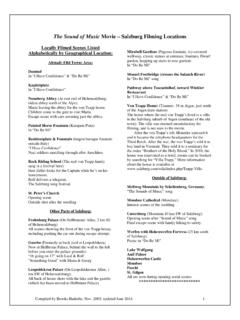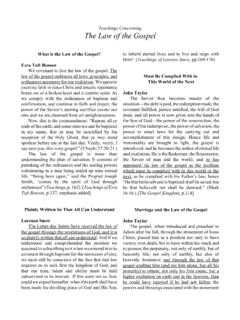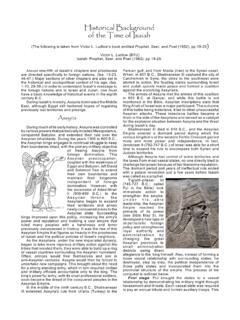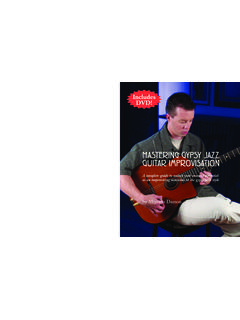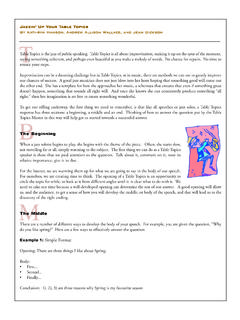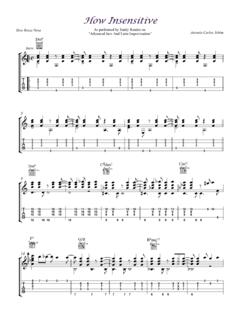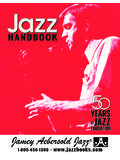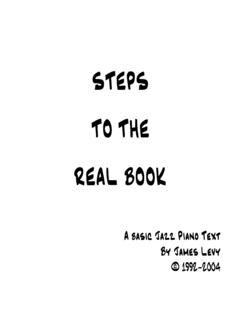Transcription of 07 Practice Techniques - Brigham Young …
1 Practice Techniques From Fundamentals of jazz improvisation : What Everybody Thinks You Already Know Dr. Mark Watkins Director of jazz Studies Brigham Young University Idaho 2010 by Mark Watkins Materials herein are provided for personal use. No part may be reproduced without written permission from the author. Patterns Almost everything in music can be considered a pattern of one type or another. There are melodic patterns, rhythmic patterns, and patterns of both melody and rhythm. Recognition of the principle of patterns is ancient.
2 The medieval composer identified a talea (rhythm) and a tonor (pitch), which they manipulated in various combinations and fragments. So it is with jazz improvisation . We use scale and arpeggio fragments, patterns standard to the tradition, and those we contrive. Patterns can be categorized into three types: 1. Circular 2. Digital 3. Melodic Circular patterns are generally based on some chord/scale type. They can be played up the range of one s instrument, down and back again. They make a loop of melodic possibility. This type is invaluable for gaining mastery of a harmony and are most often used is fragments when applied to improvisation .
3 Example (from Jerry Coker s Patterns for jazz ): Digital patterns are linked directly to a scale. When the degrees of a scale are numbered these numbers are digits. Digital pattern can be analyzed according to these digits. Example (John Coltrane Giant Steps): Melodic patterns don t fit into either of the above categories. They cannot be played in a circular fashion and their notes will not lend themselves to digital analysis due to a chromatic element not within the confines of a known scale. Example (Charlie Parker Confirmation): There are many valid reasons to study and memorize patterns.
4 1. They teach us the jazz language like a vocabulary list. We can learn to speak by mimicking jazz masters as we learned to speak by listening and mimicking our parents. 2. They teach us jazz theory. When analyzed we see the relationships between harmony and melody. We learn what works theoretically and why so that we can adapt this knowledge to other improvisational situations. Practicing patterns helps us to internalize theory and takes it beyond the intellectual to the physical. The combination of mind and body helps the language to enter our soul.
5 It helps us to use what we know. 3. They help us learn jazz style by mimicking the manner in which the notes are played (articulation, subdivision, rhythm, etc.). 4. They serve as an ear training tool, especially when patterns are transcribed (lifted from a recording, written or not). 5. They help us learn characteristics of specific tunes. Amidst the similarities every tune is unique. We can learn successful ways to improvise on a tune by learning what others have successfully done. 6. They serve as a springboard to generate other ideas.
6 One can think of a pattern and play a variation or something quite different. This generates creativity rather than stifling it. The springboard, like a diver being thrust into the air, can give us impetus when we are at a loss during an improvisation . 7. They help to develop facility over our instrument. Whether the pattern is circular, digital, or melodic, mastering patterns improves our ability to make our instruments play what we hear. Without the skill from patterns (scales and arpeggios included) we have no freedom. 8. They help to draw in the listener.
7 Solos where every note is connected to every other note in uniquely original ways are difficult for audiences to relate to. When something familiar is played the listener feels more a part of what s going on. (Overuse of known patterns is equally as objectionable or worse and will sound trite, unoriginal.) The following sections include 5 Practice Techniques or ways to work out patterns and use them to enhance jazz improvisation . These include: Practice technique #1: Circular Patterns Practice technique #2: Same Mode Sequences Practice technique #3: Pattern in 12 Keys Practice technique #4: Application Practice technique #5: Chord Progression Practice technique #6: Independence Practice technique #7: Improv Solo Composition Practice technique #1: Circular Patterns (Example: C Major, Saxophone) When preparing to improvise on a tune it is advantageous to work over each chord in the composition.
8 The following examples are in the key of C Major but can be adapted to every key and to almost any chord/scale quality. Circular patterns allow repetition. Generally, patterns should encompass the range of ones instrument from the lowest note within the key at hand to the highest reasonable note. Patterns can start on the lowest note then proceed to the highest and back or they can start on the root and progress to the top, to the bottom, and back to the root. It is essential that the instrument s full range be developed with equal proficiency.
9 All patterns are melodic and, when played with an acceptable jazz style, can be applied to improvisation . Seldom are whole patterns played intact but fragments thereof permeate the literature. Range Notes in the key of C Major on the saxophone include: Practice all patterns with the fundamental jazz articulation. (Wind instruments tongue the upbeat, slur to the downbeat; rhythm instruments play slurred with even emphasis or a slight accent on up beats. Refer to the section on articulation.) Other articulations may be appropriate; one can gain knowledge regarding articulation through concerted listening to masters and through recording and listening to oneself.
10 5 note Pattern Start the pattern on each scale degree and repeat until comfortable. Always use a metronome; when medium swing tempos are employed, click on beats two and four. Starting on each degree helps flexibility and avoids the magnetism of root to root scale Practice . This exercise also helps to strengthen extreme registers (lows and highs) and other areas of technical concern by focusing on small units. 9 note Pattern This exercise is the same as the 5 note pattern but concentrates on a larger unit. Full Range Sclae 3rds Half Octave 3rds Octave 3rds Full Range Alternate descending pattern: 4ths Half Octave 4ths Octave 4ths Full Range One can continue in like manner with 5th, 6th, 7th, and octave intervals.

